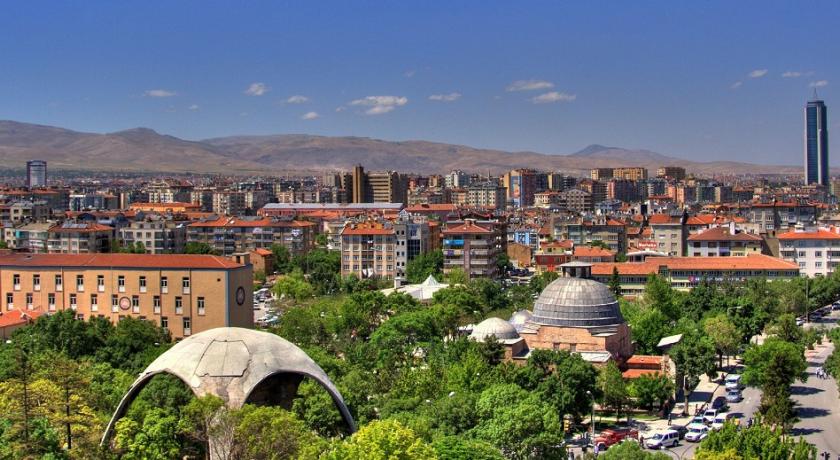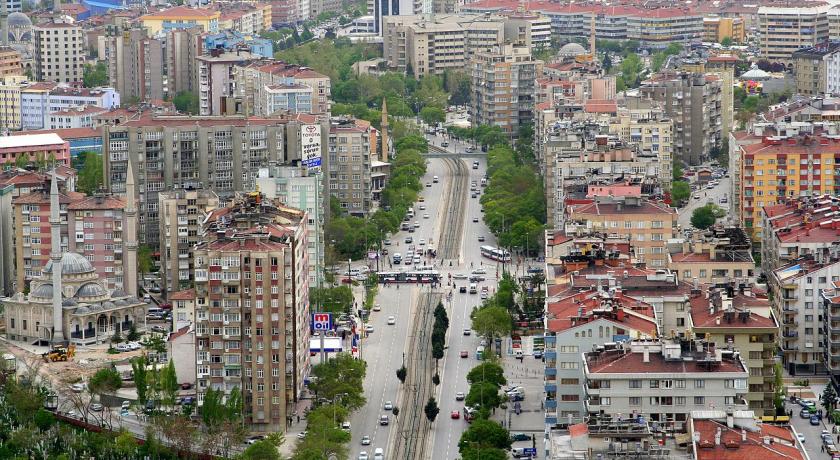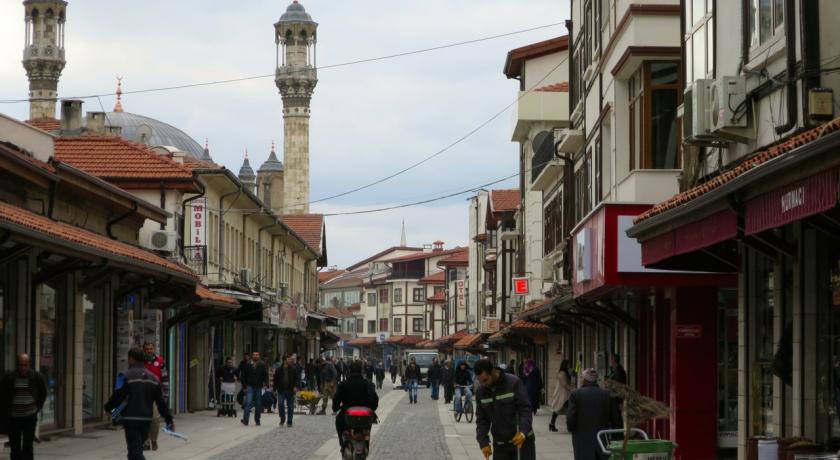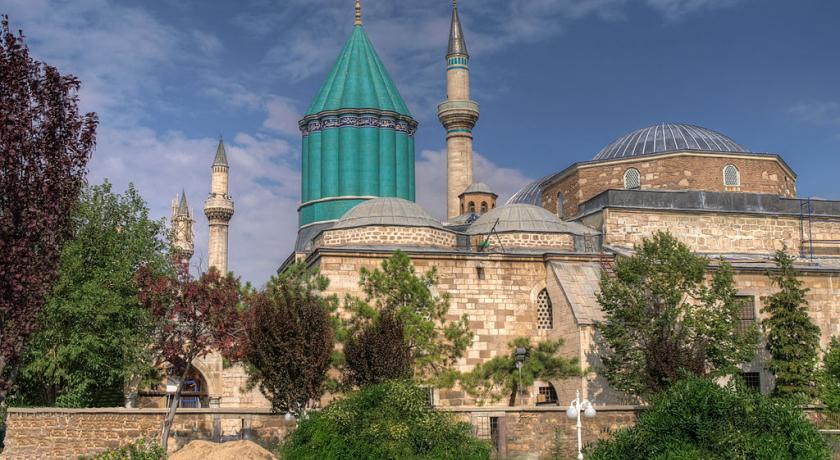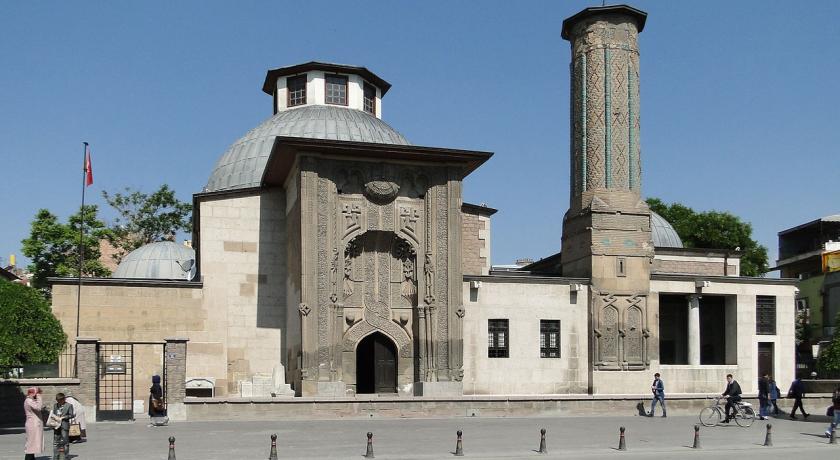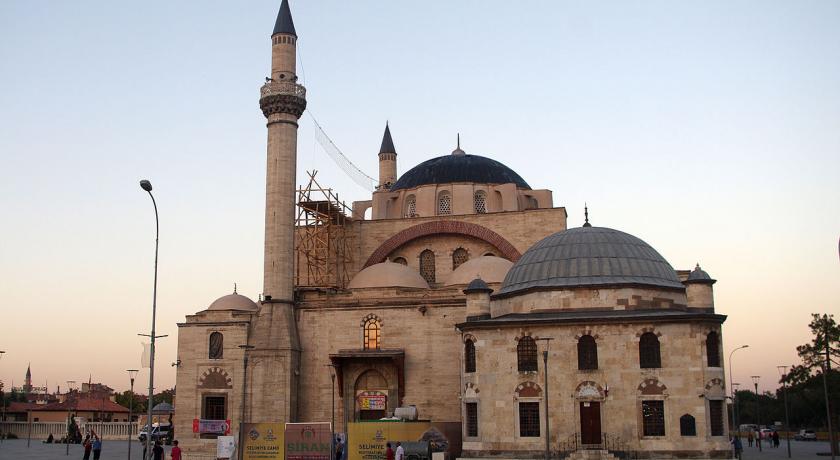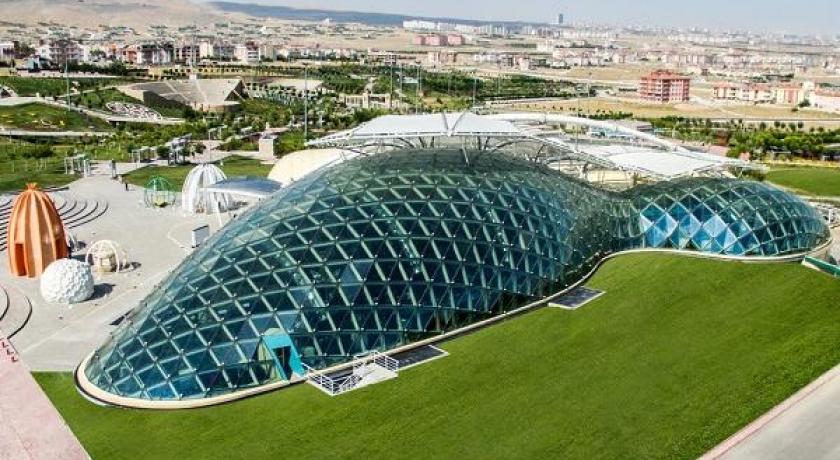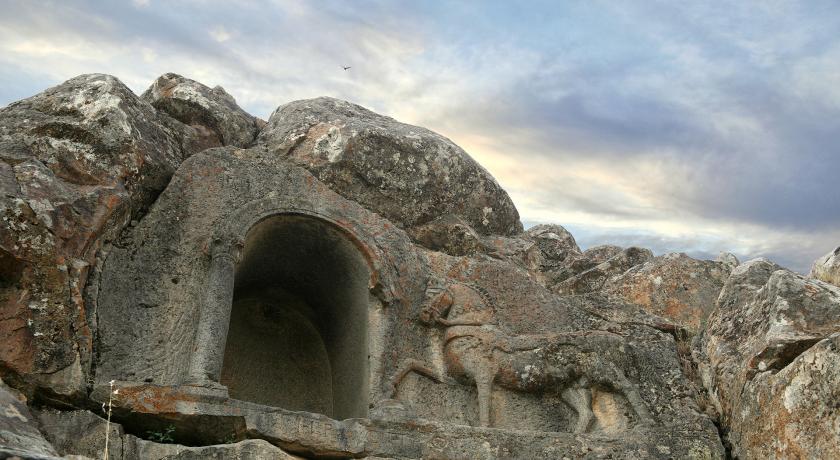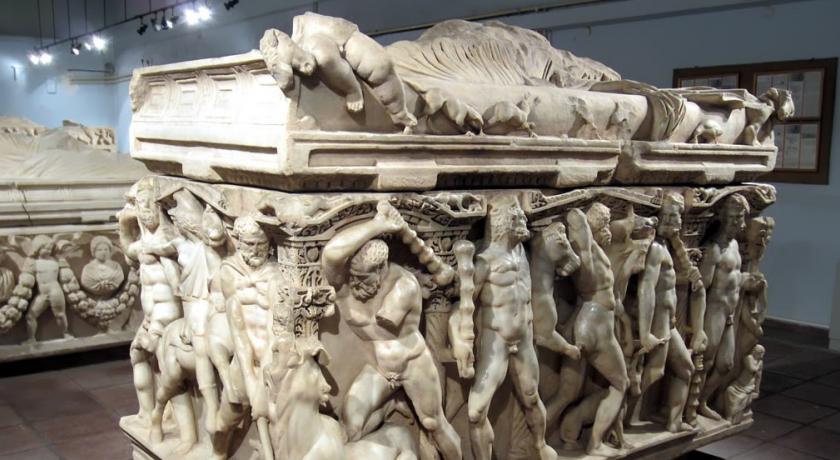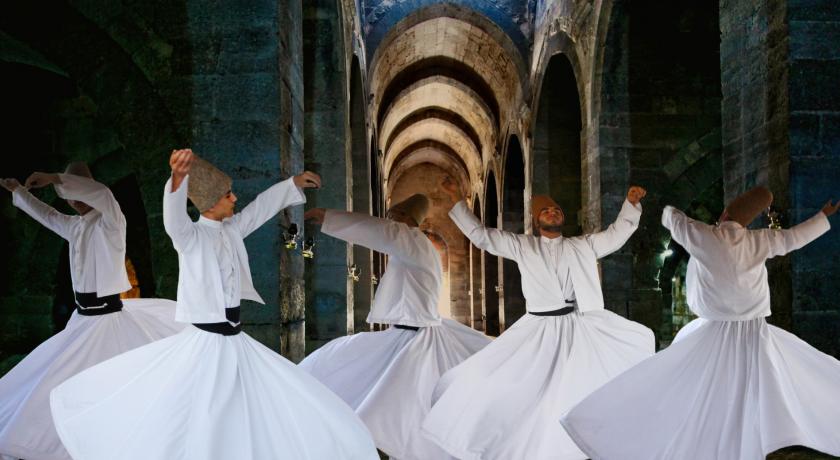Description
Konya (Turkish pronunciation: [ˈkon.ja]) is a major city in south-western edge of the Central Anatolian Plateau and is the seventh-most-populous city in Turkey with a metropolitan population of over 2.1 million. Konya is an economically and industrially developed city and the capital of Konya Province.
After its conquest by Turkish tribes, Konya became the capital of the Seljuk Sultanate of Rum (Anatolia) (1077–1308) and the Karamanids (13th century–1487).
Name
Konya, was known in classical antiquity and during the medieval period as Ἰκόνιον (Ikónion) in Greek (with regular Medieval Greek apheresis Kónio(n)) and as Iconium in Latin. This name is commonly explained as a derivation from εἰκών (icon), as an ancient Greek legend ascribed its name to the "eikon" (image), or the "gorgon's (Medusa's) head", with which Perseus vanquished the native population before founding the city. In some historic English texts, the city's name appears as Konia or Koniah.
History
Ancient history
Excavations have shown that the region was inhabited during the Late Copper Age, around 3000 BC. The city came under the influence of the Hittites around 1500 BC. Later it was overtaken by the Sea Peoples in around 1200 BC.
The Phrygians established their kingdom in central Anatolia in the 8th century BC. Xenophon describes Iconium, as the city was called, as the last city of Phrygia. The region was overwhelmed by Cimmerian invaders c. 690 BC. It was later part of the Persian Empire, until Darius III was defeated by Alexander the Great in 333 BC. Alexander's empire broke up shortly after his death and the town came under the rule of Seleucus I Nicator. During the Hellenistic period the town was ruled by the kings of Pergamon. As Attalus III, the last king of Pergamon, was about to die without an heir, he bequeathed his kingdom to the Roman Republic. Once incorporated into the Roman Empire, under the rule of emperor Claudius, the city's name was changed to Claudioconium, and during the rule of emperor Hadrianus to Colonia Aelia Hadriana.
According to the Acts of the Apostles, the apostles Paul and Barnabas preached in Iconium during their first Missionary Journey in about 47–48 AD, having been persecuted in Antioch, and Paul and Silas probably visited it again during Paul's Second Missionary Journey in about 50. Their visit to the synagogue of the Jews in Iconium divided the Jewish and non-Jewish communities between those who believed Paul and Barnabas' message and those who did not believe, provoking a disturbance during which attempts were made to stone the apostles. They fled to Lystra and Derbe, cities of Lycaonia. This experience is also mentioned in the Second Letter to Timothy,. 19th century American theologian Albert Barnes suggested that Timothy had been present with Paul in Iconium, Antioch and Lystra. The city became the seat of a bishop, which in ca. 370 was raised to the status of a metropolitan see for Lycaonia, with Saint Amphilochius as the first metropolitan bishop.
In Christian legend, based on the apocryphal Acts of Paul and Thecla, Iconium was also the birthplace of Saint Thecla, who saved the city from attack by the Isaurians.
Under the Byzantine Empire, the city was part of the Anatolic Theme. During the 8th to 10th centuries, the town and the nearby (Caballa) Kaballah Fortress (Turkish: Gevale Kalesi) were a frequent target of Arab attacks as part of the Arab–Byzantine wars.
Seljuk era
The Seljuk Turks first raided the area in 1069, but a period of chaos overwhelmed Anatolia after the Seljuk victory in the Battle of Manzikert in 1071, and the Norman mercenary leader Roussel de Bailleul rose in revolt at Iconium. The city was finally conquered by the Seljuks in 1084. From 1097 to 1243 it was the capital of the Seljuk Sultanate of Rum. It was briefly occupied by the Crusaders Godfrey of Bouillon (August 1097), and Frederick Barbarossa (May 18, 1190) after the Battle of Iconium (1190). The area was retaken by the Turks.
The name of the town was changed to Konya (in Persian: قونیه quniya) by Mesud I in 1134.
Konya reached the height of its wealth and influence in the second half of the 12th century when the Seljuk sultans of Rum also subdued the Anatolian beyliks to their east, especially that of the Danishmends, thus establishing their rule over virtually all of eastern Anatolia, as well as acquiring several port towns along the Mediterranean (including Alanya) and the Black Sea (including Sinop) and even gaining a momentary foothold in Sudak, Crimea. This golden age lasted until the first decades of the 13th century.
Many Persians and Persianized Turks from Persia and Central Asia migrated to Anatolian cities either to flee the invading Mongols or to benefit from the opportunities for educated Muslims in a newly established kingdom. By the 1220s, the city of Konya was filled with refugees from the Khwarezmid Empire. Sultan Kayqubad I fortified the town and built a palace on top of the citadel. In 1228 he invited Bahaeddin Veled and his son Rumi, the founder of the Mevlevi order, to settle in Konya.
In 1243, following the Seljuk defeat in the Battle of Köse Dağ, Konya was captured by the Mongols as well. The city remained the capital of the Seljuk sultans, vassalized to the Ilkhanate until the end of the century.
Karamanid era
Following the fall of the Anatolian Seljuk Sultanate in 1307, Konya was made the capital of a Turkish beylik (emirate); which lasted until 1322 when the city was captured by the neighbouring Beylik of Karamanoğlu. In 1420, the Beylik of Karamanoğlu fell to the Ottoman Empire and, in 1453, Konya was made the provincial capital of Karaman Eyalet.
Ottoman era
During Ottoman rule, Konya was administered by the Sultan's sons (Şehzade), starting with Şehzade Mustafa and Şehzade Cem (the sons of Sultan Mehmed II), and later the future Sultan Selim II. Between 1483 and 1864, Konya was the administrative capital of Karaman Eyalet. During the Tanzimat period, as part of the vilayet system introduced in 1864, Konya became the seat of the larger Vilayet of Konya which replaced Karaman Eyalet.
Turkish War of Independence
Konya had a major air base during the Turkish War of Independence. In 1922, the Air Force was renamed as the Inspectorate of Air Forces and was headquartered in Konya. The Third Air Wing of the 1st Air Force Command is based at the Konya Air Base. The wing controls the four Boeing 737 AEW&C Peace Eagle aircraft of the Turkish Air Force.
Population exchange between Greece and Turkey
In 1923 in the frame of the Population exchange between Greece and Turkey, the Greeks that inhabited the town of Konya left as refugees and settled in Greece. At the same time a significant influx of Albanians came and settled in the area.
Republic era
Konya was a center for agriculture at the turn of the 20th century. Since the late 20th century, the economy has diversified.
The Meram highway was constructed in 1950.
The first Konya National Exhibition and Fair was held in 1968.
The Koyunoğlu Museum was donated to the city in 1973 and it reopened in a new building.
Government
The first local administration in Konya was founded in 1830. This administration was converted into a municipality in 1876. In March 1989, the municipality became a Metropolitan Municipality. As of that date, Konya had three central district municipalities (Meram, Selçuklu, Karatay) and a Metropolitan Municipality.
Geography
Konya is the center of the largest province, the largest plain (Konya Plain) and is among the largest cities in the country. It is the seventh most populated city in Turkey.
The city is in the southern part of the Central Anatolia Region. The land is broad and flat with a lot of lowlands and plateaus. The plateaus are covered with rich steppes, therefore, affecting the agriculture sector. Additionally, the southernmost part of Konya is largely surrounded by the Taurus Mountains.
The city and the southern parts of the greater Konya enjoy abundant sunshine across the country, resulting in big potential in solar farming. The largest solar farm of Turkey is located 20 miles west of the city.
Lakes
Lake Tuz, known in Turkish as Tuz Golu, is the second-largest lake in all of Turkey. This lake supplies Turkey with a large amount of Turkey's salt demand.
Beysehir Lake is on the western part of Konya and is near the border. It is known to be the largest fresh water lake in Turkey and one of the most important national parks. Beysehir Lake is important for tourism in Konya and attracts thousands of people each year to its 2 beaches and 22 islands for water and mountain sports.
Meke Lake is on the border of the Karapinar province and is considered to be a heavily protected natural area.
Lake Aksehir is on the border of the Afyon Karahisar province and it is famous from "Nasreddin Hodja" stories. The lake also provides a good habitat for famous "Aksehir cherries".
Climate
Konya has a cold semi-arid climate (BSk) under the Köppen classification and a hot summer continental (Dca) or hot summer oceanic (Doa) climate under the Trewartha classification.
Summers temperatures average 30 °C (86 °F). The highest temperature recorded in Konya was 40.6 °C (105 °F) on 30 July 2000. Winters average −4.2 °C (24 °F). The lowest temperature recorded was −26.5 °C (−16 °F) on 6 February 1972. Due to Konya's high altitude and its dry summers, nightly temperatures in the summer months are cool. Precipitation levels are low, but precipitation can be observed throughout the year.
Education
Konya hosts the Tactical Training Center Anatolian Eagle, a center for training NATO Allies and friendly Air Forces. Real Like training environment with large area and skilled aggressors provides a training opportunity to reach the maximum combat readiness for Air Force Fighters. Official Web Site
Konya ranks among the nation's top 10 cities for the average score of high school graduates. There are various elementary and secondary schools in the province. The Meram Fen Lisesi is among Turkey's first-tier science high schools.
Konya is one of the few cities to contain more than 100,000 college students. Selçuk University had the largest number of students, 76,080, of any public university in Turkey during the 2008-09 academic year. It was founded in 1975. The other public university is Necmettin Erbakan University which was established in Konya in 2010.
Private colleges in Konya include the KTO Karatay University.
Economy
The city ranks among the Anatolian Tigers. There are a number of industrial parks. In 2012 Konya's exports reached 130 countries. A number of Turkish industrial conglomerates, such as Kombassan Holding, have their headquarters in Konya.
While agriculture-based industries play a role, the city's economy has evolved into a center for the manufacturing of components for the automotive industry; machinery manufacturing; agricultural tools; casting industry; plastic paint and chemical industry; construction materials; paper and packing industry; processed foods; textiles; and leather industry.
Transportation
Bus
The bus station has connections to a range of destinations, including Istanbul, Ankara and İzmir.
Tram
Konya has a tramway network in the city center, on which the Škoda 28 T trams are being used.
Railway
Konya is connected to Ankara, Eskişehir and Istanbul via the high-speed railway services of the Turkish State Railways.
Airport
Konya Airport is a public airport and military airbase that is also used by NATO. In 2006, Konya Airport served 2,924 aircraft and 262,561 passengers.
Notable people
- Tertius of Iconium, the amanuensis who wrote down Paul the Apostle's Epistle to the Romans
- Amphilochius of Iconium, Christian bishop of the 4rth century
- Sadr al-Din al-Qunawi disciple of Ibn Arabi and an original thinker in his own right.
- Shah Jalal Famous Sufi Muslim figure in Bangladesh
- Jalal al-Din Muhammad Rumi, also called mawlana or Mevlana, was the inspirer of the Sufi Mevlevi order (known for the Whirling Dervishes and Masnavi). He died in Konya in 1273 and his mausoleum is located here.
- Prokopios Lazaridis, Greek Orthodox metropolitan bishop of the Metropolis of Iconium
- Orkut Büyükkökten, a software engineer who developed the social networking service Orkut, was born in 1975 in Konya.
Main sights
- Mevlana Museum, formerly the tekke of Mevlana
- Sille. 8 kilometres (5.0 miles) northwest from Mevlana Museum. Antique village. mosques, churches, cave churches and catakombs on the historic Kings Road - Silky Road - Pilgrims Road to Jerusalem. Sillehan, a must see in Konya.
- Alâeddin Mosque
- Ince Minaret Medrese—Museum
- Karatay Medrese—Museum
- Aziziye Mosque
- Konya Ethnography Museum
- Konya Archaeological Museum
- Atatürk's House Museum
- İzzet Koyunoğlu City Museum
- St. Paul's Catholic Church—at Alaeddin Hill
- Seljuk Tower, the tallest building in Konya
Sports
Konyaspor is the football club of the city, that appear in Turkish Professional Football League. On May 31, 2017, he won the first national trophy of his history, winning Türkiye Kupası in the final against İstanbul Başakşehir in penalty shootout. The team repeated on August 6, 2017, following winning Türkiye Süper Kupası against Turkey's Beşiktaş champion.
Culture
Konya was the final home of Rumi (Mevlana), whose tomb is in the city. In 1273, his followers in Konya established the Mevlevi Sufi order of Islam and became known as the Whirling Dervishes. Konya has the reputation of being one of the more religiously conservative metropolitan centers in Turkey. It was once known as the "citadel of Islam" and its inhabitants are still comparatively more devout than those from other cities.
Konya produced Turkish carpets that were exported to Europe during the Renaissance. These expensive, richly patterned textiles were draped over tables, beds, or chests to proclaim the wealth and status of their owners, and were often included in the contemporary oil paintings as symbols of the wealth of the painter's clients.
A Turkish folk songs is named Konyalım, Konyalıya Güzel Derler and Konyalım Yaman Çalar Şak Şak Kaşığı, making reference to a loved one from Konya.
The local cuisine of Konya includes dishes made of bulgur wheat and lamb meat. One of the renowned dishes of the city is etli ekmek, which is similar to lahmacun and pizza.
Food:
Etliekmek – flat bread baked with ground meat, peppers, onions, and tomatoes
Pişmaniye – similar to American cotton candy and resembling a fully white ball of yarn
Firun kebab – over-cooked meat (usually lamb)
Various candies – Konya is known for its sweets, including cezerye, an old Turkish sweet made of carrots
Tirit – a traditional rice dish that is made with meat and various vegetables
Tavak suyu – a tomato broth-based soup made with shredded chicken and noodles
Source: https://en.wikipedia.org/wiki/Konya
Address
Konya
Turkey
Lat: 37.874641418 - Lng: 32.493156433


